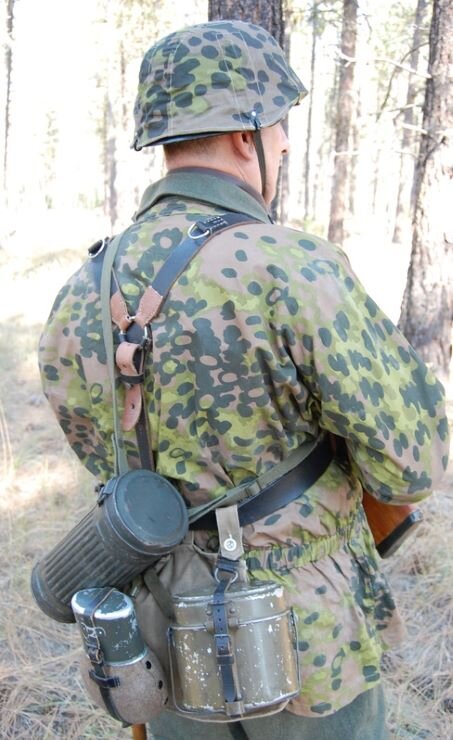Deutschland Regiment:
SS-Mann, I./ SS-Standarte, “Deutschland”:
SS-Standarte “Deutschland” was formed in 1934, as Standarte 2/ Verfügungstruppe from Politische Bereitschaft Württemberg, Politische Bereitschaft München, and Hilfswerk Schleissheim (Austrian Volunteers).
It was soon renamed SS-Standarte 1 / VT when Hitler ordered the Leibstandarte Adolf Hitler would not be included in the numbering sequence, it was renamed Standarte Deutschland at the Parteittag at Nuremberg in 1935 and at the same time, it also received its Deutschland Erwache Standard.
The command of this unit was transferred to the Army during the mobilization in October 1938. It took part in the Annexation of Austria and later the occupation of the Sudetenland. It was in Bohemia and Moravia in March 1939. It was ordered by Hitler that it should be expanded into a Division, but it was postponed due to the outbreak of war. It took part in the Invasion of Poland while attached to the Panzer-Division Kempf, and following that campaign, it was used to form the SS-Division Verfügungstruppe (which was later renamed, Das Reich).
This SS Soldier wears the first-pattern VT uniform, which was noticeably different from the Heer-pattern tunic of the period in that it did not have the bottle green stand and fall collar, as it was meant to be worn open with a shirt and tie. The uniform also has lower slash pockets and a back fitting like that of the black SS tunic. He wore a black leather belt with an enlisted buckle with a holstered sidearm, and black marching boots with the uniform’s matching trousers. The uniform was often covered in the “Plain Tree” or Bloch Pattern Camouflage Smock, also used on his helmet’s cloth cover when he went in the field.
A note to all the Black and White pictures at the bottom: Notice all the variations of the insignia as the uniform evolves.
SS–Unterscharfüher. Ewald Ehm, 16. Panzerpioneerabteilung “Deutschland”:
Historical data about SS-Unterscharführer Ehm is slim. What is known about him is that he was a bold and aggressive leader and combatant and was the commander of the 16. Kompanie of the Panzerpioneerabteilung of the 2. SS-Panzer-Grenadier-Division “Das Reich” in early Februar 1943. Part of the III. Bataillon of the Abteilung fought with SS Panzer-Grenadier-Regiment “Deutschland".
He was recognized as the first member of the division to single-handedly destroy a 58-ton T-35 tank in August 1941 near Yelnja. In February 1943, he was awarded the Eiserne Kreuz I. Klasse for his decisive leadership in mounting a counter-attack against a Soviet night attack. Ehm moved his troops quickly through eight different positions, deceiving the enemy into thinking his Kompanie was a regimental-strength unit. Out in front during the attack on Otrada on 19 February, Ehm and his men located and marked mines to ensure the regiment's armored spearhead could attack without major casualties.
At Kharkiv, on 12 February, Ehm and his men were one of the first divisional units to penetrate the western edge of the Red Army defense. On 22 February, Ehm individually destroyed another Russian tank, and then on the 24th at Pavlograd, Ehm and his group broke into a strong point of about 50 Russians and destroyed them down to the last man in bitter hand-to-hand combat.
Ehm was awarded the Deutsche Kreuz in Gold in September 1943 and was then sent to officer training. He returned to his old command as an SS -SS-Untersturmführer. Wearing the wartime Dienstanzug Model 1940 while sitting for his DKG portrait, he wears a white piped Schirmmütze für Unterführer. He may well have had a black piped Feldmütze für Unterführer for field use.
SS-VT Deutschland Custom Smock:
Again, sorry, there is no story other than it’s a modified battle smock. The SS were the first armed forces to use camouflage to a large extent and as an issued item, but it was with helmet covers and their shelter quarters. Then came the Smock, customized smocks, and 4-pocket jackets came from there. Last-minute issue uniforms were coming out all over with whatever patterns were available then.
But it’s worn with just a shirt now, no jacket underneath, it’s like a windbreaker jacket. This was not standard practice by any means and was nonregulation and with the use of the company tailor, or a locally acquired one. These things did happen, generally from necessity, and this is one of those overlooked ones.
The Smock was, as I said, a garment to be worn over the uniform with all the gear. This Smock now was the coat, and likely his gear would have been worn over this. , with the Green side out of the SS-Oak Pattern. It’s been customized with the zipper, though; a collar was added, and shoulder boards with the later-war subdued tress, and over them, cipher slides (loop) with a white chain-stitched “D” centered on them.
The uniform has adapted 2 caps for use with it, an oak-pattern camouflage M40 type hat, and a light-summer weight overseas cap, with typical SS insignia. Both would be acceptable, but even more so would be a Steel Hemlmet, with a similar pattern camouflaged cover on it. The Trousers were wool, but as it seems, it was a time of warm weather, he could have had a set of HBT trousers and low boots rather than the marching boots.
















































